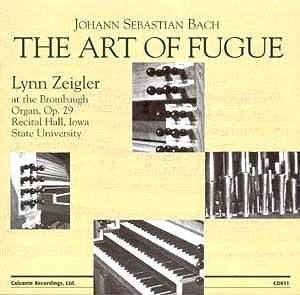 Review of Johann Sebastian Bach: The Art of Fugue, BWV 1080
Review of Johann Sebastian Bach: The Art of Fugue, BWV 1080
Performer: Lynn Ziegler, organ
Recording: CALCANTE CD 011
Duration: Disc 1 [41:30] Contrapunctus 1-10; Disc 2 [43:27] Contrapunctus 11, 12a, b, 13a, b (mirror fugues), Canon 14-16, Contrapunctus 14
Rec: May 1994, Brambaugh Organ, Recital Hall, Iowa State University
Johann Sebastian Bach’s The Art of Fugue, an exploration of counterpoint and a testament to the composer’s genius, stands as one of his final statements in music, embodying the very essence of his artistic vision. In this recording by organist Lynn Ziegler, the work is presented not merely as an auditory experience but as a complex treatise on the art of counterpoint, an approach that, while illuminating in some respects, ultimately undermines the emotional depth inherent in Bach’s music.
Ziegler’s interpretation begins with commendable clarity in the initial fugues. The polyphonic lines emerge distinctly, allowing the listener to appreciate Bach’s intricate weaving of themes. However, as the registration choices grow bolder, one notes a diminishing transparency in the sound. This is particularly evident in the more complex fugues, where the interplay of voices can become obscured, detracting from the structural clarity that is essential to understanding Bach’s contrapuntal language. For instance, in Contrapunctus VI, the pedal lines occasionally seem to lag behind the upper voices, creating a sense of rhythmic dissonance that distracts rather than enhances the overall coherence.
The liner notes, penned by Jeffrey Prater, suggest that this recording serves more as a resource for organists than as a listening experience for the broader audience. Indeed, there is an emphasis on registration techniques, with six pages devoted to the organ’s capabilities and only two to discussing the music itself. While the technical aspects of registration are fascinating, they should not overshadow the profound emotional landscape that Bach constructs through his music. Ziegler’s choices, while innovative, occasionally yield performances that feel overly cerebral and lacking the warmth that can evoke the listener’s engagement. This is particularly evident in the mirror fugues, where the mechanistic quality of the interpretation can overshadow the lyrical potential of the themes.
For comparison, André Isoir’s recent recording on Calliope offers a more nuanced approach. Isoir imbues his performance with a palpable sense of emotion and a dynamic interplay among the voices, providing a richer listening experience. His interpretative choices foster a dialogue between the themes, allowing the listener to appreciate the emotional weight of the music, a quality that Ziegler’s rendition sometimes lacks.
The engineering quality of this recording is commendable, capturing the resonant qualities of the Brambaugh organ effectively. The sound is well-balanced, allowing the individual lines to emerge with clarity, even in the denser fugues. However, it must be noted that the engineering cannot compensate for a lack of interpretative depth. The final fugue, while executed with technical precision and showcasing the organ’s capabilities to their fullest, feels somewhat anticlimactic, as the emotional arc of the work remains unfulfilled.
A point of contention arises in the liner notes regarding the contributions of Mei-Chu Yen, who assists in the performance of the mirror fugues. The absence of her name on the CD’s cover is regrettable, particularly in a work that requires such collaboration. Acknowledging the contributions of all performers involved is not merely a matter of courtesy but a necessity in understanding the performance context, especially in a work as collaborative as The Art of Fugue.
In conclusion, while Ziegler’s recording of The Art of Fugue displays commendable technical proficiency and an attractive organ sound, it ultimately serves as a more informative resource for organists rather than an emotionally resonant performance for the general listener. The interpretation, though clear in its execution, lacks the warmth and expressive depth that is so vital to Bach’s music. As we continue to explore this monumental work, it is imperative to seek performances that honor both its technical intricacies and its profound emotional landscape, allowing Bach’s voice to resonate fully within the listener’s experience.



![Bach’s Sacred Works: A Captivating Exploration by [ Performer Name ]](https://classicalguy.com/wp-content/uploads/2024/11/cover-339.jpg)